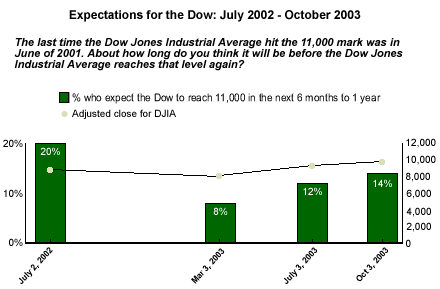It was September 1999, and the bellwether Dow Jones Industrial Average was trading in the 11,000 range. That month, James Glassman and Kevin Hassett released a book titled, Dow 36,000: The New Strategy for Profiting from the Coming Rise in the Stock Market, in which they argued that the Dow was enormously undervalued at 11,000. The authors predicted a dramatic correction in the next few years, and that the index would eventually reach what they estimated as its "fair value": 36,000.
As it turned out, there was a correction of a different kind. While Glassman and Hassett theorized that shrinking equity risk premiums were behind the inexplicable valuations, we now know that Fed Chairman Alan Greenspan was closer to the truth when he suggested the market was infected with an "irrational exuberance." Four years later, our speculations are more modest; the big question now is: Will the Dow touch the 11,000 mark again soon?
A Modest Speculation
The last time the Dow Jones Industrial Average hit 11,000 was in June 2001. As part of the October 2003 UBS/Gallup Index of Investor Optimism survey*, Gallup asked investors how long they believe it will be before the index touches that level again.
Fourteen percent of investors believe that the Dow Jones will reach 11,000 within the next year. However, a plurality of investors (34%) are less optimistic about immediate-term prospects and predict that the index will climb to 11,000 within one or two years. Nearly one in four investors (24%) believe that it will be more than three years before the Dow reaches 11,000 again. At the margin are the most bearish investors -- the 6% who believe that the Dow will never hit the 11,000 mark again.

While investors are less exuberant in their predictions for the Dow than they were over a year ago, their sentiment has inched upward in recent months -- in March 2003, just 8% expected the Dow to reach 11,000 within a year, compared to 14% today.
When Gallup asked the same question in July 2002, 20% of investors were optimistic that the Dow would touch 11,000 within a year. The Dow closed at 8,736 in July 2002, and rose by more than 5% to 9,233 in July 2003 -- still far short of 11,000. In July 2003, investors were significantly less optimistic: Only 12% believed it was foreseeable that the Dow would reach the 11,000 mark within the next year.

Bottom Line
For a long time now, the so-called economic recovery has been characterized as one in which consumers keep spending even as corporations cut back and job losses continue. With strong corporate profits and capital spending picking up again, it looks like businesses are joining the party and the recovery is for real. The UBS/Gallup Index of Investor Optimism reflects that investors are adjusting their expectations for stock market performance upward. And though Dow 36,000 might not be a reality just yet, the next bull market could be right around the corner.
*Results for the Index of Investor Optimism -- U.S. are based on telephone interviews with a randomly selected U.S. sample of 802 adult investors, aged 18 and older, with at least $10,000 of investable assets, conducted Oct. 1-16, 2003. For results based on this sample, one can say with 95% confidence that the maximum error attributable to sampling and other random effects is ±4 percentage points. In addition to sampling error, question wording and practical difficulties in conducting surveys can introduce error or bias into the findings of public opinion polls.

